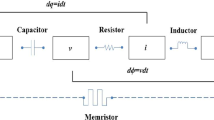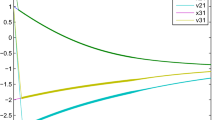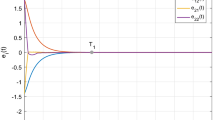Abstract
This thesis’s object is inertial memristive neural networks (IMNNs) with proportional delays and switching jumps mismatch. Different from the traditional bounded delay, the proportional delay will be infinite as t → ∞. The finite-time synchronization (FN-TS) and fixed-time synchronization (FX-TS) can be realized with the devised controllers for the drive-response systems (D-RSs). Along with the Lyapunov function and some inequalities, the synchronization criteria of D-RSs are given. This paper presents an optimization model with minimum control energy and dynamic error as objective functions, aiming to obtain more accurate and optimized controller parameters. An intelligent algorithm: particle swarm optimization with stochastic inertia weight (SIWPSO) algorithm is introduced to solve the optimization model. Meanwhile, an integrated algorithm for selecting optimal control parameters is presented as well. In this method, the optimal control parameters and the setting time of synchronization can be obtained directly. At last, some simulations are presented to verify the theorems and the optimization model.
Similar content being viewed by others
References
G. Aquino, A. Zacarias, J. D. J. Rubio, J. Pacheco, G. J. Gutierrez, G. Ochoa, and J. F. Novoa, “Novel nonlinear hypothesis for the delta parallel robot modeling,” IEEE Access, vol. 8, no. 1, pp. 46324–46334, 2020.
I. Elias, J. D. J. Rubio, D. I. Martinez, T. M. Vargas, V. Garcia, D. M. Vargas, and A. Zacarias, “Genetic algorithm with radial basis mapping network for the electricity consumption modeling,” Appl. Sci., vol. 10, no. 12, 4239, 2020.
G. Hernández, E. Zamora, H. Sossa, G. Téllez, and F. Furlán, “Hybrid neural networks for big data classification,” Neurocomputing, vol. 390, pp. 327–340, 2020.
F. Parastesh, S. Jafari, H. Azarnoush, B. Hatef, H. Namazi, and D. Dudkowski, “Chimera in a network of memristor-based Hopfield neural network,” Eur. Phys. J. Spec. Top., vol. 228, no. 10, pp. 2023–2033, 2019.
R. Samli, S. Senan, E. Yucel, and Z. Orman, “Some generalized global stability criteria for delayed Cohen- Grossberg neural networks of neutral-type,” Neural Netw., vol. 116, pp. 198–207, 2019.
F. Wang, Y. Q. Yang, X. Y. Xu, and L. Li, “Global asymptotic stability of impulsive fractional-order BAM neural networks with time delay,” Neural Comput. Appl., vol. 28, no. 2, pp. 345–352, 2017.
K. Babcock and R. Westervelt, “Stability and dynamics of simple electronic neural networks with added inertia,” Phys. D, vol. 23, pp. 464–469, 1986.
V. T. Pham, S. Jafari, S. Vaidyanathan, C. Volos, and X. Wang, “A novel memristive neural network with hidden attractors and its circuitry implementation,” Sci. China Technol Sc., vol. 59, no. 3, pp. 358–363, 2016.
J. Yang, L. Wang, Y. Wang, and T. Guo, “A novel memristive Hopfield neural network with application in associative memory,” Neurocomputing, vol. 227, pp. 142–148, 2017.
Y. Sheng, T. Huang, Z. Zeng, and P. Li, “Exponential stabilization of inertial memristive neural networks with multiple time delays,” IEEE Trans. Cybern., vol. 51, no. 2, pp. 579–588, 2021.
G. Zhang, Z. Zeng, and J. Hu, “New results on global exponential dissipativity analysis of memristive inertial neural networks with distributed time-varying delays,” Neural Netw., vol. 97, pp. 183–191, 2018.
F. Wang and Y. Yang, “Quasi-synchronization for fractional-order delayed dynamical networks with heterogeneous nodes,” Appl. Math. Comput., vol. 339, pp. 1–14, 2018.
X. Yang, J. Lam, D. W. Ho, and Z. Feng, “Fixed-time synchronization of complex networks with impulsive effects via nonchattering control,” IEEE T. Automat Contr., vol. 62, no. 11, pp. 5511–5521, 2017.
L. Zhang and Y. Yang, “Finite time impulsive synchronization of fractional order memristive BAM neural networks,” Neurocomputing, vol. 384, pp. 213–224, 2020.
W. Zou, P. Shi, Z. Xiang, and Y. Shi, “Finite-time consensus of second-order switched nonlinear multi-agent systems,” IEEE Trans. Neural Netw. Learn. Syst., vol. 31, no. 5, pp. 1757–1762, 2020.
L. Zhou, “Delay-dependent exponential stability of cellular neural networks with multi-proportional delays,” Neural Process. Lett., vol. 38, no. 3, pp. 347–359, 2013.
F. Wang and Y. Yang, “Intermittent synchronization of fractional order coupled nonlinear systems based on a new differential inequality,” Phys. A, vol. 512, pp. 142–152, 2018.
F. Wang, Y. Yang, and M. Hu, “Asymptotic stability of delayed fractional-order neural networks with impulsive effects,” Neurocomputing, vol. 154, pp. 239–244, 2015.
F. Wang and Y. Yang, “On leaderless consensus of fractional-order nonlinear multi-agent systems via event-triggered control,” Nonlinear Anal-Model., vol. 24, no. 3, pp. 353–367, 2019.
S. Li, C. Ahn, and Z. Xiang, “Sampled-data adaptive output feedback fuzzy stabilization for switched nonlinear systems with asynchronous switching,” IEEE Trans. Fuzzy Syst., vol. 27, no. 1, pp. 200–205, 2019.
L. Zhang and Y. Yang, “Optimal quasi-synchronization of fractional-order memristive neural networks with PSOA,” Neural Comput. Appl., vol. 32, pp. 9667–9682, 2020.
Q. Chang, A. Hu, Y. Yang, and L. Li, “The optimization of synchronization control parameters for fractional-order delayed memristive neural networks using SIWPSO,” Neural Process. Lett., vol. 51, pp. 1541–1556, 2020.
Q. Chang, Y. Yang, X. Sui, and Z.C. Shi, “The optimal control synchronization of complex dynamical networks with time-varying delay using PSO,” Neurocomputing, vol. 333, pp. 1–10, 2019.
C. Chen, L. Li, H. Peng, and Y. Yang, “Fixed-time synchronization of inertial memristor-based neural networks with discrete delay,” Neural Netw., vol. 109, pp. 81–89, 2019.
R. Wei, J. Cao, and A. Alsaedi, “Finite-time and fixed-time synchronization analysis of inertial memristive neural networks with time-varying delays,” Cogn. Neurodyn., vol. 12, no. 1, pp. 121–134, 2018.
A. M. Alimi, C. Aouiti, and E. A. Assali, “Finite-time and fixed-time synchronization of a class of inertial neural networks with multi-proportional delays and its application to secure communication,” Neurocomputing, vol. 332, pp. 29–43, 2019.
A. F. Filippov and F. M. Arscott, Differential Equations with Discontinuous Right Hand Sides: Control Systems, Springer, Berlin, 2013.
C. Chen, L. Li, H. Peng, Y. Yang, and T. Li, “Finite-time synchronization of memristor-based neural networks with mixed delays,” Neurocomputing, vol. 235, pp. 83–89, 2017.
G. Barbaraci and G. V. Mariotti, “Sub-optimal control law for active magnetic bearings suspension,” Journal of Control Engineering and Technology (JCET), vol. 2, no. 1, pp. 1–10, 2012.
Author information
Authors and Affiliations
Corresponding authors
Additional information
This work was jointly supported by the Natural Science Foundation of Jiangsu Province of China under Grant No.BK20170171.
Qi Chang received her B.S. degree in information and computing science from Jiangnan University in 2017. Now she is a Ph.D. candidate in the School of IoT Engineering, Jiangnan University. Her research interests include memristive neural networks, parameter optimization, and finite-time synchronization.
Yongqing Yang received his B.S. degree from Anhui Normal University, an M.S. degree from Anhui University of Science and Technology, and a Ph.D. degree from Southeast University, in 1985, 1992, and 2007, respectively. His research interests include nonlinear systems, neural networks, and optimization.
Li Li received her B.S. degree in mathematics and an M.S. degree in applied mathematics from Anhui Normal University, a Ph.D. degree in control science and engineering from Jiangnan University, in 2001, 2007, and 2016, respectively. Her research interests include neural networks and computational intelligence.
Fei Wang received his B.S. and Ph.D. degrees from Jiangnan University, in 2013 and 2018, respectively. His research interests include dynamic and control of fractional order systems and nonlinear systems.
Publisher’s Note
Springer Nature remains neutral with regard to jurisdictional claims in published maps and institutional affiliations.
Rights and permissions
About this article
Cite this article
Chang, Q., Yang, Y., Li, L. et al. The Optimization of Control Parameters: Finite-time and Fixed-time Synchronization of Inertial Memristive Neural Networks with Proportional Delays and Switching Jumps Mismatch. Int. J. Control Autom. Syst. 19, 2491–2499 (2021). https://doi.org/10.1007/s12555-020-0425-6
Received:
Revised:
Accepted:
Published:
Issue Date:
DOI: https://doi.org/10.1007/s12555-020-0425-6




